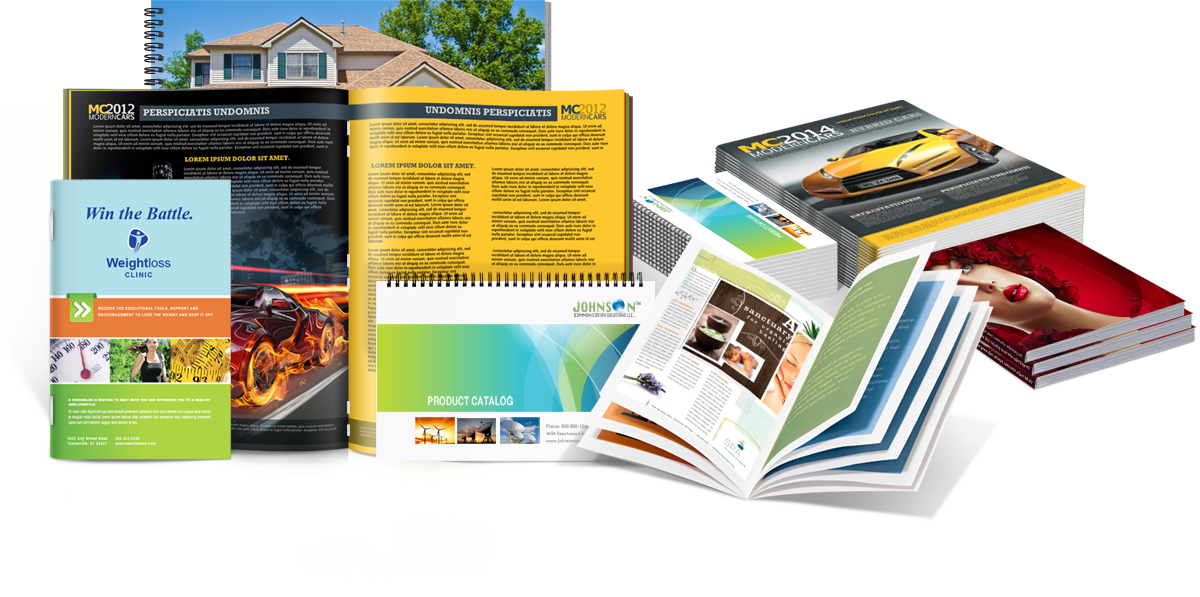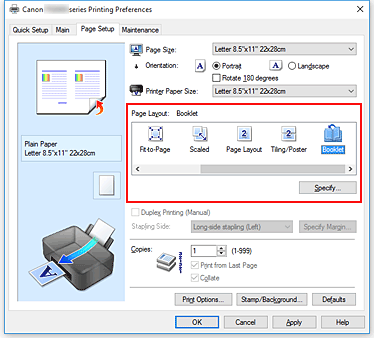How Booklet Printing Supports Omni-Channel Marketing Strategies
How Booklet Printing Supports Omni-Channel Marketing Strategies
Blog Article
The Vital Overview to Comprehending Booklet Printing Options and Techniques
The process of brochure printing includes several considerations that can greatly impact the last item. From selecting the suitable format and size to recognizing the nuances of binding approaches, each choice plays an important duty. Furthermore, factors such as paper supply and printing strategies additional influence the efficiency of the brochure. As one navigates these options, it comes to be imperative to comprehend just how they interconnect and what that implies for the overall result.
Comprehending Pamphlet Formats and Dimensions
When considering brochure printing, recognizing the various formats and dimensions readily available is important for accomplishing the desired presentation. Brochures can be generated in numerous styles, consisting of saddle-stitched, spiral-bound, and perfect-bound, each offering distinctive advantages. Common sizes vary from typical letter (8.5 x 11 inches) to smaller alternatives like A5 (5.8 x 8.3 inches), enabling flexibility based upon material and target audience.Selecting the ideal dimension can influence both the format and visitor involvement. Larger dimensions might suit aesthetically driven content, while smaller sized formats may be a lot more user-friendly and mobile. Furthermore, the number of web pages affects the selection of binding approach, as thicker pamphlets may need sturdier bindings. Ultimately, understanding these aspects permits an extra customized method, ensuring that the last product straightens with the designated message and aesthetic, boosting the overall efficiency of the interaction.
Choosing the Right Paper Supply

Binding Approaches: Considerations and options
When it comes to binding methods for pamphlets, several options are available, each with distinct advantages. Saddle stitch binding uses an economical option for thinner booklets, while perfect binding strategies supply a more sleek seek thicker publications. Wire-O binding sticks out for its toughness and convenience of use, making it optimal for records that call for flexibility.
Saddle Stitch Binding
Saddle stitch binding supplies a useful and affordable solution for setting up brochures, making it a popular option among authors and companies. This binding approach involves folding sheets of paper in fifty percent and stapling them along the fold line, creating a well organized and neat appearance. Typically suitable for booklets with a lower page matter, saddle sewing is ideal for magazines, sales brochures, and instructional materials. The simplicity of this method permits quick manufacturing and is usually preferred for brief runs or promotional things. It is necessary to note that saddle stitch binding might not be suitable for thicker brochures, as the back may not hold up under raised weight. On the whole, it remains a trustworthy alternative for many printing jobs.
Perfect Binding Strategies
Perfect binding is an extensively used method that offers a expert and sleek finish to booklets and magazines. This method includes gluing the pages together at the back using a solid adhesive, enabling a clean side and the capacity to hold a larger variety of web pages contrasted to saddle sewing. Perfect binding is particularly ideal for thicker brochures, such as brochures and yearly records, where a sturdy, flat spinal column is desired. Additionally, it uses the alternative for a published cover that can be designed to improve aesthetic charm. Nonetheless, factors to consider such as web page matter, paper weight, and the intended usage of the pamphlet should be thought about, as they can affect longevity and overall quality.
Wire-O Binding Alternatives
Wire-O binding, known for its durability and adaptability, provides an exceptional alternative for brochures that call for simple page transforming and an expert look. This binding approach employs a collection of steel loops that hold web pages safely, permitting them to lie level when open. It is specifically ideal for presentations, catalogs, and handbooks due to its robust nature. Wire-O binding is offered in different colors and sizes, suiting different page counts and densities. In addition, it allows the inclusion of covers and tabs, enhancing the booklet's general aesthetic. Considerations for Wire-O binding consist of the option of cord shade, the dimension of the loopholes, and the extent of customization desired, every one of which can greatly influence the end product's appearance and capability.
Digital vs. Offset Printing: Which Is Best for You?
When picking a printing approach for pamphlets, comprehending the distinctions in between electronic and offset printing is essential. Digital printing makes use of contemporary innovation to generate premium prints promptly and cost effectively, making it optimal for short runs or jobs needing fast turnaround times. It allows for personalization, providing the capacity to publish on-demand with very little waste.In comparison, balance out printing is a standard technique that masters generating huge amounts with regular top quality. It includes moving ink from a plate to a rubber blanket, after that to the paper, which causes vibrant colors and specific information. Nonetheless, balance out printing normally needs longer configuration times and is much more affordable for bigger volumes.Ultimately, the choice between electronic and counter printing relies on project demands, budget plan, and preferred amount. For little, time-sensitive tasks, electronic may be the most effective option, while balanced out might be more effective for bigger, high-quality manufacturings.

Designing Your Brochure: Tips and Best Practices
When making a brochure, cautious interest to format, font style selection, and color usage can considerably improve its effectiveness. A well-structured layout guides the visitor's eye, while ideal font styles assure readability and convey the wanted tone. In addition, effective usage of color can evoke feelings and emphasize essential info, making the total layout extra impactful.
Picking the Right Design
Exactly how can one properly choose the appropriate format for a pamphlet? It is vital to evaluate the booklet's purpose and target audience. A tidy, organized design enhances readability and interaction. Using a grid system can assist in lining up aspects regularly, developing a professional appearance. Furthermore, incorporating visual pecking order with varying sizes and positionings of photos and text can assist the visitor's eye and stress key details. It is likewise crucial to leave enough white room, which avoids congestion and permits far better emphasis. Finally, evaluating various formats via mock-ups can supply understanding right into just how the layout carries out in real-world scenarios, making sure that the end product meets both visual and practical demands.
Choosing Suitable Fonts
An appropriate typeface can considerably boost the total design of a brochure, enhancing the layout and strengthening the content's message. The choice of font styles must think about readability, specifically for body text, as it assures the information comes to all visitors. Sans-serif font styles are typically liked for digital styles, while serif typefaces can offer a traditional feel in published materials. It's recommended to limit font choices to two or three to preserve visual coherence. In addition, font size plays an important role; headings must be not frustrating but distinct, while body message must fit for reading. When choosing font styles, placement with the brochure's motif and target audience is necessary for efficient interaction and visual charm.
Effective Usage of Shade
Shade acts as an effective device in booklet layout, guiding and shaping understandings visitor emotions. It can evoke feelings of enjoyment, count on, or peace, depending find on the shades picked. Developers should think about shade concept concepts, ensuring that the picked combination straightens with the pamphlet's message and target audience. For instance, utilizing cozy shades like red and orange can develop urgency, while cooler tones like environment-friendly and blue foster tranquility.Additionally, comparison plays an important role; complementary shades can boost readability and aesthetic appeal. Uniformity in shade use throughout web pages further strengthens brand name identity and communication. Eventually, reliable color application not just captures focus but additionally enhances the brochure's function, making it an important element of successful layout.
Ending Up Touches: Coatings and Special Effects
While lots of take into consideration the material and layout of a booklet the most essential elements, the finishing touches, such as coverings and unique effects, play a vital role in improving its general charm. Coatings can offer security and toughness, ensuring that the pamphlet holds up against damage. Matte surfaces offer an innovative, non-reflective surface area, while shiny layers can make colors appear more appealing and vivid. Special effects, like embossing or aluminum foil marking, add a responsive measurement that can develop an unforgettable perception. These techniques can highlight particular areas, drawing attention to important details or producing aesthetic rate of interest. In addition, UV finish can provide a high-shine coating that raises the overall look.Together, these completing touches not just improve the brochure's aesthetic yet likewise interact professionalism and trust and interest to detail, eventually leaving an enduring impact on the viewers.
Expense Factors To Consider for Brochure Printing
Recognizing the various cost considerations for pamphlet printing is necessary for organizations and organizations intending to optimize their budget plans. Secret variables influencing expenses include the option of paper, ink, and binding techniques. Greater high quality materials, such as premium paper or specialized inks, usually enhance the overall expenditure. Additionally, the dimension and web page matter of the pamphlet play a significant function; bigger pamphlets need more resources and time to produce.Another crucial factor to consider is the printing method, whether electronic or countered, as each has its own rates framework and viability for various quantities. Organizations should additionally consider design expenses, which can vary based on complexity and making use of specialist services. Inevitably, delivery and handling costs can include to the overall, specifically for large orders. By evaluating these aspects, organizations can make educated choices that straighten with their monetary capacities while achieving the preferred top quality in their published materials.
Often Asked Questions
What Are the Ecological Effects of Booklet Printing?
The ecological impacts of pamphlet printing include logging from paper production, carbon exhausts from transportation, and waste generation from disposed of products - Booklet Printing. Sustainable practices, such as utilizing recycled paper and eco-friendly inks, can reduce these effects
Exactly How Can I Guarantee Color Precision in My Booklet?
To ensure shade precision in a booklet, one should make use of calibrated screens, utilize specialist shade profiles, conduct test prints, and choose premium printing solutions that provide shade matching and proofing alternatives for ideal outcomes.
What Is the Normal Turn-around Time for Brochure Printing?
The common turn-around time for redirected here pamphlet printing differs depending upon the intricacy and quantity - Booklet Printing. Typically, it varies from a few days to two weeks, affected by factors such as publishing techniques and completing needs
Are There Minimum Order Quantities for Pamphlet Printing?

Can I Print Brochures in Several Languages?
Publishing brochures in numerous languages is feasible. Numerous printing services supply alternatives for check these guys out multilingual or multilingual designs, enabling efficient interaction. Careful preparation guarantees that make components suit various languages without endangering readability or looks. In addition, aspects such as paper supply and printing techniques further affect the efficiency of the pamphlet. When thinking about brochure printing, understanding the different layouts and dimensions available is important for accomplishing the desired presentation. When choosing a printing method for booklets, comprehending the distinctions in between electronic and offset printing is vital. Furthermore, the size and page matter of the pamphlet play a substantial role; larger brochures require more resources and time to produce.Another vital consideration is the printing strategy, whether digital or countered, as each has its very own pricing structure and viability for various amounts. The ecological impacts of brochure printing include logging from paper manufacturing, carbon exhausts from transport, and waste generation from disposed of products.
Report this page